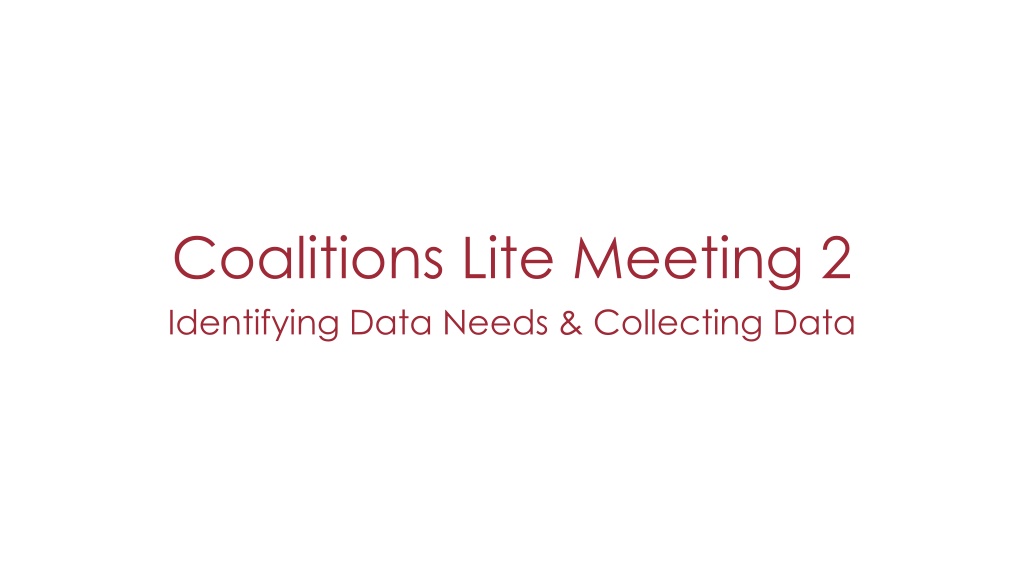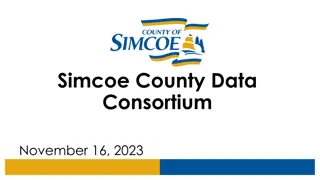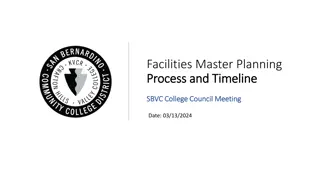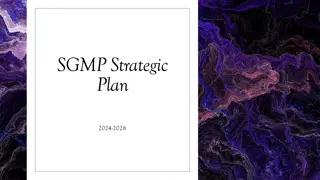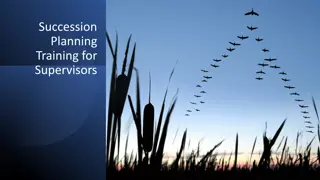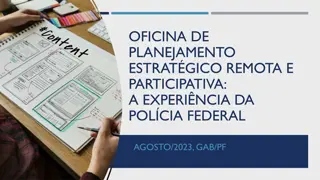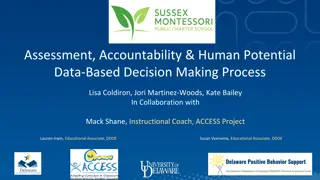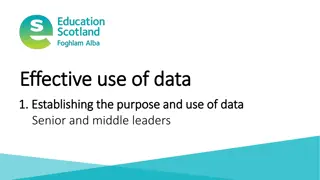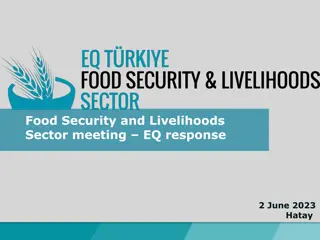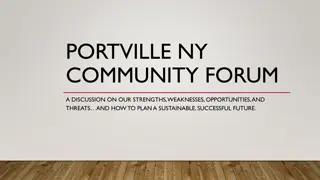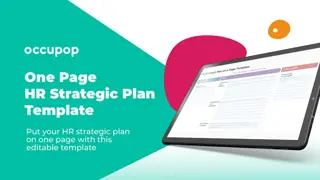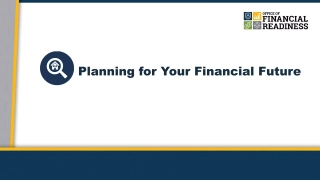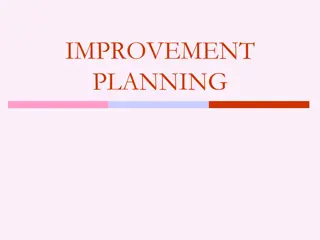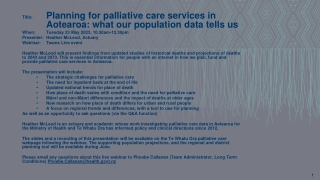Strategic Planning Meeting: Identifying Data Needs & Prioritizing Issues
This meeting focuses on identifying data needs, selecting priority issues for the strategic plan, and preparing for key stakeholder interviews. The agenda includes discussions on prioritizing issues based on data sets and voting for top choices. Meeting objectives aim to fill knowledge gaps and outline next steps efficiently.
Download Presentation
Please find below an Image/Link to download the presentation.
The content on the website is provided AS IS for your information and personal use only. It may not be sold, licensed, or shared on other websites without obtaining consent from the author. Download presentation by click this link. If you encounter any issues during the download, it is possible that the publisher has removed the file from their server.
Presentation Transcript
Coalitions Lite Meeting 2 Identifying Data Needs & Collecting Data
Welcome, Introductions, & Overview 15 minutes
Meeting Logistics and Overview 1. 2. 3. Team check-in and introductions Identify a notetaker and timekeeper Review access to shared documents
Meeting Objectives 1. Select and specify the broader issue(s) to prioritize in the strategic plan 2. Review knowledge gaps 3. Identify and select data sources to fills our knowledge gaps 4. Prepare for the key stakeholder interviews 5. Review the tools for Step 2b (data collection / interviews) 6. Outline next steps This meeting moves quickly! Perfection not required!
Assignments from Meeting #1 [FILL IN ASSIGNMENTS FROM MEETING #1]
Select Our Priority Issue(s) 25 minutes
Short List of Possible Priority Issues [ENTER LIST FROM MEETING #1]
Which Issues Should We Prioritize? What jumps out at you for each of these data sets? Do any of these data sets depict big enough problems that this issue should be prioritized above other issues? Have we already prioritized any of the issues (through our current activities, discussions, etc.)? Does anyone feel very strongly about one of these issues? Why or why not? Consider all these points in your decision to avoid 1) pet priorities that aren t backed up by data and 2) priorities shown in the data that the coalition is not inspired by!
Vote! Each person gets ONE vote Raise your hand for your first choice The top 1-2 issues win
Check-In: Thumb Vote! Do these top 1-2 issues feel right? Yes! Maybe, can we discuss? Nope!
Specify Our Priority Issue(s) 10 minutes
Knowledge Gaps Knowledge gaps indicate what we need to learn more about to better understand our issue A clear understanding of our issue will help us select the best strategies and solutions If you don t know why, you can t solve the problem! We will briefly explore the first two gaps now AND research all three during Step 2b The 3 knowledge gaps we will focus on include: 1) 1) What What is the specific issue we should focus on? (specify the issue) 2) 2) Who Who does the issue affect most in our community? (population) 3) 3) Why Why is this issue happening in our community? (contributing factors)
Knowledge Gap 2: Who does the issue(s) affect most in our community?
Identify & Select Data Sources 25 minutes
Data Sources Information Sheet - Databases Public Health Indicator Based Information System (IBIS) Utah Open Data Catalog Healthy Salt Lake SHARP (Student Health and Risk Prevention) Survey Utah Healthy Places Index Census Utah State Epidemiological Outcomes Workgroup (SEOW)
Data Sources Information Sheet - Organizations Chamber of Commerce Large employers Civic organizations Law enforcement agencies Community college/local university Local DA/courts/attorneys Counseling centers Non-profit organizations Employment Security Commission Schools and school districts Faith-based groups Community members Health Department Environmental scans Hospitals and healthcare providers
How Can We Fill Our Knowledge Gaps? Where can we find information about what the specific issue is, who is experiencing it, and why it is occurring? Who in our community knows a lot about the issues? Remember: Data can be both people (interviews) and numbers (graphs and charts)! Focus on local data. The minimum data collection required is interviews with stakeholders. Even if you don t have numbers and charts, you can learn a lot by talking to local people in the know. Aim for three knowledgeable stakeholders to interview for each priority issue.
Which Data Sources Should We Use? For each priority issue, select three data sources from the brainstormed list. In selecting the best data sources, consider: Our timeline for data collection and interviews Our availability Which data sources can give us information on more than one of our knowledge gaps? Which data sources can give us the most and the best information? Which data sources do we have access to?
Prepare for Stakeholder Interviews 15 minutes
Interview Questions Open the Stakeholder Interview Form. Revise / add / delete any questions, as needed. Take out the examples and notes so you have a clean list of questions. Aim for no more than ten questions per interview no more than ten questions per interview. Be clear about which questions are being asked of each interviewee. Don t worry about the perfect wording. Just be sure the questions will fill your knowledge gaps.
Elevator Speech Decide talking points for your interviews Include: the reason for the interview how the data will be used who will have access to it any benefits for the interviewee
Collecting the Data 25 minutes
Who will collect which data? Assign each data review and interview to a team member. Consider: Members strengths, time, and comfort with the type of data to be collected. Distribute the workload among members. Reviewing surveys and databases can be done at any time but may feel person conducting the interview already has a connection to the interviewee. overwhelming. Stakeholder interviews are easy and take about 30 minutes but require more time for data summarizing afterwards and you ll need to accommodate interviewee schedules. If anyone knows the selected interviewee, it s helpful for that person to make the connection.
Expectations for Data Collection Timeline: All data should be collected in time for Meeting #3. Set or update the meeting schedule based on the amount of time you ll need to collect and review your data. Accountability: How should we monitor our progress? Format: Members doing interviews should use the Stakeholder Interview Form conduct and organize their interviews. The notetaker will need to email out the updated Interview Form with the interview questions immediately after the meeting. Process: Members doing interviews should review the Interview Checklist. During interviews, ask follow-up questions as needed. If you don t understand a response, ask for clarification! ask for clarification! This is especially important for the why if you get a vague response, ask the stakeholder to elaborate as much as they can until you have a very clear and specific why. Stakeholder Interview Form to
Expectations for Summarizing Data All members need to summarize their data collection / interviews in the Interview Summary Tool Interview Summary Tool (bottom of Interview Form) Review the Data Summary Tool Example [LINK] Everyone must use the Summary Tool, or it will be difficult to merge information in the next meeting. Bring any supporting documents to the next meeting Charts or graphs, Stakeholder Interview Forms, interview transcripts, etc. Decide deadline for submitting the data summaries to coordinator prior to the next meeting Be sure the facilitator has enough time to review the summaries.
Incentives Can we offer interviewees any incentives? Are we able to cover members expenses for data collection and interviews?
Interview / Data Tool Review 10 minutes
Tool Review Data Tips Explains how to look at and understand number data. Anyone reviewing number or quantitative data should review this information sheet on their own. Interview Checklist Steps for members to follow while conducting key stakeholder interviews. Anyone conducting interviews should review this information sheet on their own. Key Stakeholder Interview Form Provides a list of suggested interview questions, a guide for the interview, and a place to summarize the individual interview responses. Complete one form per interview. Data Summary Tool(bottom of the Stakeholder Interview Form) & Example Data Summary Tool The Data Summary tool summarizes the findings of each piece of data or interview. Everyone fills this out, whether you re reviewing numbers data or conducting interviews. Interviewers will fill it out after the interview. Review the Example Data Summary Tool Information Sheet to get an idea of how to fill this form out.
Wrap-Up and Next Steps 10 minutes
Assignments Notetaker: Email out the updated Interview Form with revised interview questions Notetaker: Make sure all information and decisions from flip chart sheets are captured in the notes and send the notes out quickly Review any relevant forms or information sheets Review your data / conduct your interviews If you have questions don t wait! Ask someone before the next meeting Summarize your data afterwards Submit your data summaries to the coordinator by [DATE] Update relevant stakeholders regarding the work done in Meeting #2
Prepare for Meeting #3 DATE: TIME: LOCATION: Meeting #3 will focus on consolidating the data collected in Step 2b to clarify the priorities in the strategic plan. Members should complete their data assignments and keep the group updated on their progress. Members should come prepared to share and discuss their results.
Check-Out Discussion: How did this meeting go? What worked well or didn t work well with the meeting? How can we run our future meetings better?
Celebrate! We re on our way to selecting our priorities!
